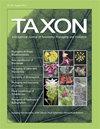A revised tribal classification of Papaveraceae (poppy family) based on molecular and morphological data
IF 2
2区 生物学
Q2 EVOLUTIONARY BIOLOGY
引用次数: 0
Abstract
Papaveraceae, commonly known as the poppy family, contains many species with horticultural and/or pharmaceutical importance and has been the subject of various molecular studies. However, a widely accepted tribal classification for Papaveraceae remains lacking. In this study, we used a sampling covering all 48 of the currently recognized genera of Papaveraceae. Our study is to employ broad morphological data in combination with sequence data from two nuclear and seven plastid DNA regions to reconstruct phylogenetic relationships within the family. Our analyses indicate that Pteridophylloideae is sister to the clade containing Hypecooideae and Fumarioideae, and these three lineages are in turn sister to Papaveroideae. The alternative topologies constraining Pteridophylloideae as sister to the other poppy species, to Papaveroideae or to Hypecooideae, as recovered in previous studies, are all rejected. Fumarioideae contains nine main clades, and Fumarieae is nested in traditional Corydaleae. Within Papaveroideae, three main clades are recovered and Platystemoneae is embedded within traditional Papavereae. Both topologies constraining traditional Corydaleae or Papavereae as monophyletic are significantly rejected. Within this phylogenetic framework, the evolution of selected characters is inferred and diagnostic morphological characters at different taxonomic levels are identified and discussed. Based on morphological and molecular evidence, a new tribal classification of Papaveraceae is presented, in which 4 subfamilies, 14 tribes (including 7 newly described tribes), and 43 genera are recognized.基于分子和形态学数据修订的罂粟科部落分类法
罂粟科通常被称为罂粟家族,其中有许多物种具有重要的园艺和/或医药价值,并且一直是各种分子研究的主题。然而,目前仍缺乏一个被广泛接受的罂粟科部落分类法。在这项研究中,我们采用了涵盖目前公认的全部 48 个罂粟属的样本。我们的研究将广泛的形态学数据与两个核DNA区和七个质粒DNA区的序列数据结合起来,重建该科内的系统发育关系。我们的分析表明,Pteridophylloideae 与包含 Hypecooideae 和 Fumarioideae 的支系是姐妹支系,而这三个支系又与 Papaveroideae 是姐妹支系。以往研究中认为 Pteridophylloideae 与其他罂粟属物种、Papaveroideae 或 Hypecooideae 是姐妹关系的其他拓扑结构均被否定。Fumarioideae 包含九个主要支系,Fumarieae 嵌套在传统的 Corydaleae 中。在 Papaveroideae 中,发现了三个主要支系,Platystemoneae 嵌套在传统的 Papavereae 中。将传统的堇菜科(Corydaleae)或木贼科(Papavereae)作为单系的拓扑结构都被明显否定。在这一系统发育框架内,推断了所选特征的演化,并确定和讨论了不同分类水平上的诊断性形态特征。根据形态学和分子证据,提出了新的木犀科部落分类法,其中确认了 4 个亚科、14 个部落(包括 7 个新描述的部落)和 43 个属。
本文章由计算机程序翻译,如有差异,请以英文原文为准。
求助全文
约1分钟内获得全文
求助全文
来源期刊

Taxon
生物-进化生物学
CiteScore
4.70
自引率
8.80%
发文量
177
审稿时长
6-12 weeks
期刊介绍:
TAXON is the bi-monthly journal of the International Association for Plant Taxonomy and is devoted to systematic and evolutionary biology with emphasis on plants and fungi. It is published bimonthly by the International Bureau for Plant Taxonomy and Nomenclature, c/o Institute of Botany, Slovak Academy of Sciences, Dúbravská cesta 9, SK-845 23 Bratislava, SLOVAKIA. Details of page charges are given in the Guidelines for authors. Papers will be reviewed by at least two specialists.
 求助内容:
求助内容: 应助结果提醒方式:
应助结果提醒方式:


